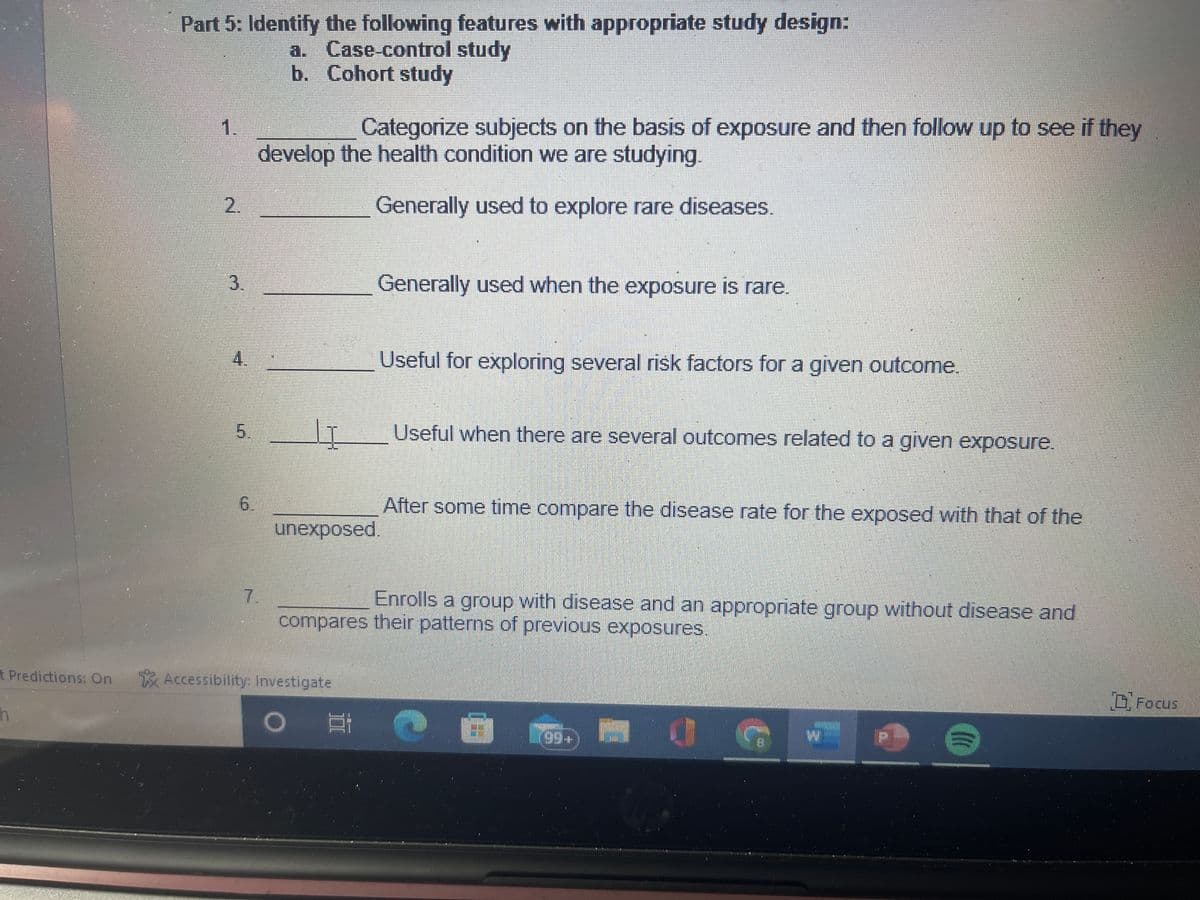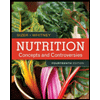Part 5: Identify the following features with appropriate study design: a. Case-control study b. Cohort study 1. 2. 3. 4. 5. 6. Categorize subjects on the basis of exposure and then follow up to see if they develop the health condition we are studying. Generally used to explore rare diseases. 7. JI Generally used when the exposure is rare. Useful for exploring several risk factors for a given outcome. unexposed. Useful when there are several outcomes related to a given exposure. After some time compare the disease rate for the exposed with that of the Enrolls a group with disease and an appropriate group without disease and compares their patterns of previous exposures.
Part 5: Identify the following features with appropriate study design: a. Case-control study b. Cohort study 1. 2. 3. 4. 5. 6. Categorize subjects on the basis of exposure and then follow up to see if they develop the health condition we are studying. Generally used to explore rare diseases. 7. JI Generally used when the exposure is rare. Useful for exploring several risk factors for a given outcome. unexposed. Useful when there are several outcomes related to a given exposure. After some time compare the disease rate for the exposed with that of the Enrolls a group with disease and an appropriate group without disease and compares their patterns of previous exposures.
Comprehensive Medical Assisting: Administrative and Clinical Competencies (MindTap Course List)
6th Edition
ISBN:9781305964792
Author:Wilburta Q. Lindh, Carol D. Tamparo, Barbara M. Dahl, Julie Morris, Cindy Correa
Publisher:Wilburta Q. Lindh, Carol D. Tamparo, Barbara M. Dahl, Julie Morris, Cindy Correa
Chapter45: The Medical Assistant As Human Resources Manager
Section: Chapter Questions
Problem 45.1CS
Related questions
Question

Transcribed Image Text:Part 5: Identify the following features with appropriate study design:
a. Case-control study
b. Cohort study
1.
3.
4.
5.
6
Categorize subjects on the basis of exposure and then follow up to see if they
develop the health condition we are studying.
Generally used to explore rare diseases.
7.
LI
Generally used when the exposure is rare.
unexposed.
t Predictions: On Accessibility: Investigate
h
Useful for exploring several risk factors for a given outcome.
Ei
Useful when there are several outcomes related to a given exposure.
Enrolls a group with disease and an appropriate group without disease and
compares their patterns of previous exposures.
After some time compare the disease rate for the exposed with that of the
H
0
(
Focus
Expert Solution
This question has been solved!
Explore an expertly crafted, step-by-step solution for a thorough understanding of key concepts.
This is a popular solution!
Trending now
This is a popular solution!
Step by step
Solved in 3 steps with 1 images

Recommended textbooks for you

Comprehensive Medical Assisting: Administrative a…
Nursing
ISBN:
9781305964792
Author:
Wilburta Q. Lindh, Carol D. Tamparo, Barbara M. Dahl, Julie Morris, Cindy Correa
Publisher:
Cengage Learning

Case Studies In Health Information Management
Biology
ISBN:
9781337676908
Author:
SCHNERING
Publisher:
Cengage

Nutrition: Concepts and Controversies - Standalo…
Health & Nutrition
ISBN:
9781305627994
Author:
Frances Sizer, Ellie Whitney
Publisher:
Brooks Cole

Comprehensive Medical Assisting: Administrative a…
Nursing
ISBN:
9781305964792
Author:
Wilburta Q. Lindh, Carol D. Tamparo, Barbara M. Dahl, Julie Morris, Cindy Correa
Publisher:
Cengage Learning

Case Studies In Health Information Management
Biology
ISBN:
9781337676908
Author:
SCHNERING
Publisher:
Cengage

Nutrition: Concepts and Controversies - Standalo…
Health & Nutrition
ISBN:
9781305627994
Author:
Frances Sizer, Ellie Whitney
Publisher:
Brooks Cole

Nutrition Through The Life Cycle
Health & Nutrition
ISBN:
9781337919333
Author:
Brown, Judith E.
Publisher:
Cengage Learning,